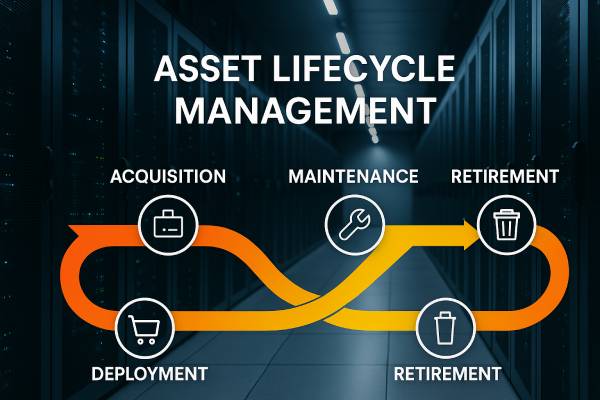AI and high-performance computing (HPC) are pushing data center thermal loads to new extremes. Today’s facilities are routinely seeing 40–70 kW racks, and many are preparing for densities of 130 kW or more. Traditional air cooling is nearing its functional limit — and for colocation and enterprise operators, this is no longer a future concern. It’s already impacting performance, energy costs, and risk.
If you’re managing a critical facility, maintaining uptime now means staying ahead of escalating heat — with real-time visibility, smarter planning, and clean data. That’s exactly what MCIM delivers.
What’s Driving Thermal Pressure in Today’s Data Centers?
- AI and HPC workloads generating record-breaking rack densities
- Air cooling infrastructure topping out at ~70 kW
- Rising energy consumption, with cooling consuming up to 40% of total power
- Inconsistent procedures and siloed systems delaying response times
Staying Ahead of Escalating Thermal Loads
Identify and Monitor Thermal Risk Zones in Real Time
- Monitoring module integrates data from sensors, BMS, DCIM, and field rounds
- Set thresholds for temperature, humidity, and receive instant alerts
- Use barcode-enabled scanning and space-based tours for pinpoint data collection
- Asset and Critical Area tools let you visualize cooling/electrical capacity by room
This means you’ll see where thermal pressure is building — and fix it before failure.
As heat loads intensify, hotspots can appear quickly and unpredictably. MCIM’s Monitoring module allows real-time collection of temperature and humidity data from both manual rounds and integrated systems like BMS, DCIM, and sensors. You can set asset-specific operating thresholds and receive automated alerts if conditions deviate, reducing the chance of equipment overheating. Barcoded asset scanning and space-based tour configurations also enable targeted data collection where it matters most—on the floor.
With Asset Management and Critical Area Database capabilities, operators can map dependencies and visualize cooling and electrical capacity by space. This gives you a clear, data-backed picture of where thermal pressure is building—and where cooling systems need reinforcement.
Optimize Cooling Efficiency and Energy Use
- Use Intelligent Analytics to trend PUE and identify energy outliers
- Facility Condition Index (FCI) or Asset Condition Index (ACI) scoring helps plan proactive maintenance
- Surface underperforming equipment or overloaded zones to prioritize upgrades
By catching inefficiencies early, you prevent thermal strain and reduce energy bills.
Cooling systems can account for 30–40% of a facility’s energy use. When thermal loads rise, so do operating costs, unless you intervene early. MCIM makes it easier to find inefficiencies and optimize energy use by delivering structured, clean data from across your environment.
Use MCIM’s Intelligent Analytics to trend performance, spot cooling outliers, and optimize for better Power Usage Effectiveness (PUE). Asset Condition Index (ACI) scoring helps track asset condition and exception states across the cooling infrastructure, giving you a proactive, data-driven path to maintenance and upgrade decisions.
Digitize and Standardize Cooling SOPs
- Execute critical procedures (chiller maintenance, pump switchovers) on mobile
- Version-controlled workflows ensure consistency across teams and shifts
- Support compliance with audit-ready logs of every cooling action taken
Eliminating human error in thermal-sensitive tasks reduces operational risk.
Thermal risk doesn’t just stem from equipment – it also comes from inconsistent human processes. MCIM’s Work module includes digital, version-controlled operating procedures for tasks like chilled water system testing, pump switchovers, and air handler maintenance. These workflows can be executed on mobile devices, ensuring that high-risk activities are done the right way every time, even under pressure.
Audit-ready compliance reporting gives you confidence when regulators or customers ask how you’re maintaining safe thermal operating conditions in your facility.
Plan for Liquid Cooling, Hybrid Designs, and Retrofitting
- Model lifecycle costs and transition strategies with Capital Planning
- Track execution of upgrades like immersion cooling or direct-to-chip systems
- Maintain operational visibility and documentation throughout retrofit phases
MCIM enables a data-driven cooling strategy — not just a reaction to heat.
As liquid cooling adoption accelerates in response to escalating heat loads, many facilities are retrofitting targeted zones. MCIM supports this shift by helping operators assess facility readiness, manage capital upgrades, and maintain documentation throughout the transition.
With MCIM’s Capital Planning, you can model lifecycle costs, justify new investments, and track project execution without losing operational visibility. Whether you’re upgrading CRAC units or integrating a new direct-to-chip liquid cooling system, MCIM ensures the effort is coordinated and data-backed.
Turn Thermal Risk into Resilience
AI workloads aren’t slowing down and neither are rack densities. In this high-heat future, operational resilience depends on smarter tools. With MCIM, data center operators gain the insight, visibility, and operational control to tackle rising heat loads while improving energy efficiency and staying compliant.
Download the Data Center Survival Guide – a practical resource packed with insights, checklists, and tools used by today’s leading operators to stay ahead of disruption. Whether you’re facing power ceilings or planning for growth, this guide is your next move. Click here to download the guide today!



